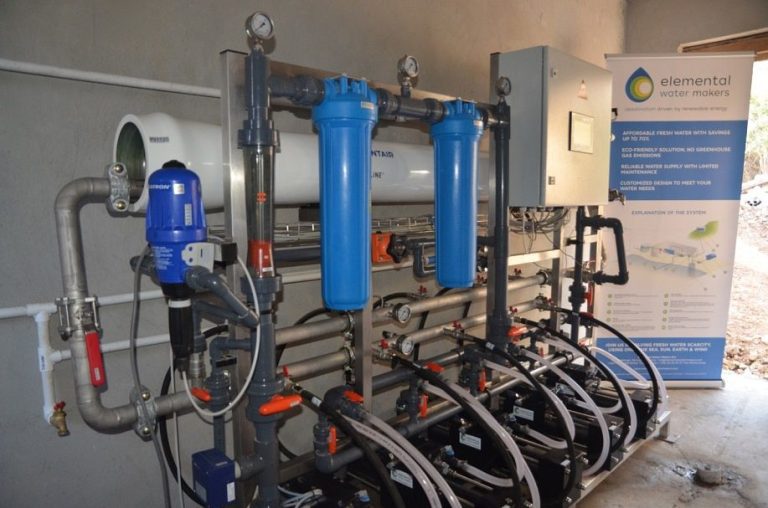The Dutch company Elemental Water Makers delivered its first solar-powered desalination plant to the Virgin Islands last weekend. Their technology enables inhabitants to produce drinking water from seawater with solar energy.
The Virgin Islands have very little rain, lots of sun and an affluent population. There are dozens of small isolated islands and a large number of luxury hotels. All that in combination with the lack of drinking water makes the island group an excellent springboard for the Dutch start-up company Elemental Water Makers (EWM) that produces drinking water with solar energy or wind energy. Last weekend, they delivered their first operational installation without much ceremony. They do now have a demonstration site just north of the main island Tortola where they can show prospect customers around. The plant uses 12 kilowatt peak of solar power to produce 12.5 cubic meters of drinking water per day by reverse osmosis.
Reverse osmosis combines high pressure with advanced ceramic filters to squeeze fresh water from sea water. Despite constant technological improvements, it’s still an energy-intensive process that requires about three kilowatthours to produce one cubic meter of sweet water from seawater. The energy involved pushes up the price for drinking water. According to EWM’s Sid Vollebregt, Virgin Island inhabitants pay €6.00-7.00 for a cubic metre of drinking water. For comparison, in the Netherlands, people pay €0.80-1.70 per cubic metre. Vollebregt says EWM’s installation produces drinking water for €1.00-3.00 per cubic metre. “The upfront investment is larger than for a conventional installation, but once in operation, our plant has no fuel costs, just the maintenance.”
At the main island Tortola, a large plant that produces 800 times more water (10,400 m3/day) was delivered at the end of last year. The size is obviously different, and so is the energy provision. The so-called Biwater plant is powered with conventional electricity.
Sustainable energy and reverse osmosis are hard to combine. Reverse osmosis is a typical continuous process that doesn’t function with fluctuating pressures. Sustainable energy, however, varies with the amount of sun or wind available. In theory, batteries could be used to flatten the peaks and troughs in energy production. In practice EWM has chosen for another method: hydrostatic pressure. EWM’s engineers Sid Vollebregt and Reinoud Feenstra make use of an elevated basin for the sea water. The hydrostatic pressure powers the reverse osmosis process.
The required pressure to produce drinking water from sea water is about 50 bar, which is equivalent to 500 metres of height difference. A smart device called Energy Recovery Device (ERD) reduces that required height difference to only 90 metres, which is within the geography of the island Great Camanoe where EWM’s first installation is located.

Vollebregt can’t reveal details about their Energy Recovery Device. Functionally, it uses the high-pressure outlet of the brine (extra salt water) to increase the pressure of the incoming sea water. There are more ways in which this can be done. “We use a piston-based pressure intensifier that works purely mechanical. We’ve found the technology in another application. We’ve patented the entire system configuration”, Vollebregt said over the telephone from the Virgin Islands
Over the next couple of weeks, Vollebregt and Feenstra will receive representatives from hotels and resorts to show them the island’s first sustainable drinking water plant. National attitudes toward photovoltaic (PV) panels vary. German hotels will put them in the front lawn while US hotels prefer to hide PV panels behind a fence. But the interest in producing drinking water for a fraction of the current price unites them. “Especially with the long drought we’re experiencing here at the moment, the timing of our plant couldn’t be better”, said Vollebregt.
News updates will appear on EWM’s Facebook page



Comments are closed.